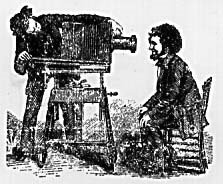
There are two ways to tell you’ve arrived at the Blue Moon Tavern, located at 712 NE 45th St. in the University District. The first indicator is the signature blue neon sign hanging over the sidewalk that features a nude woman sitting on a crescent moon. The second is the animated sculpture on sentry duty outside the door, known as “The Hammered Man,” by artist Jim St. John (a video is available below). According to Gus Hellthaler, the owner, the physical space is approximately 45 feet wide by 40 feet deep and occupies about 1800 square feet. The space is visually and physically divided by the bar, which creates a narrow row of booths along the west side of the tavern, and a larger space on the east side which has an open area and also is lined with booths along the eastern perimeter.
Who goes there: The age of the customers varies from University of Washington student types around the age of 21, to “hippie”-type people in their 50s (or maybe older). An employee, Bill H. says the average number of customers ranges from a dozen to 99, but is more often around a dozen. Both men and women go to the Blue Moon. Because of its fame/notoriety, I think some people go there out of curiosity (like me), and some expect to undergo some sort of illuminating or cathartic experience (because of the legendary notables who once hung out there). In order for humanity to survive, people need places where they can gather, talk, meet, be creative, and express themselves. Humans are social animals with the desire to be among other people. The Blue Moon Tavern is a place where people can do these things.
The Blue Moon is a historic site in the U-District where people today mostly go to hang out, drink beer, talk and listen to music, but some of its former customers, who went there for the same reasons, went on to be culturally and historically important.
Glory days: In the 1950s some of the Blue Moon regulars included National Book Award-winner Richard Hugo; future Pulitzer Prize-winning poets Carolyn Kizer, Stanely Kunitz and James Wright; and it attracted notables Dylan Thomas, poet and James Farrell, author, who would stop in whenever they passed through Seattle. (P. 12, Crowley) Other highly esteemed literary figures who made pilgrimages to the Blue Moon included writer Jack Kerouac, and poets Allen Ginsberg, and Lawrence Ferlinghetti. (P. 15, Crowley). Historian and writer Walt Crowley reported Theodore Roethke regularly conducted gatherings of budding poets and writers in the Blue Moon’s back booths, and [U.W.] campus lore, “maintains Roethke celebrated receiving the Pulitzer Prize at the Blue Moon in 1954.” (P. 12, Crowley). There’s an overwhelming sense that this space had seen the presence of greatness, even though today it could be easily seen as a dive.

No comments:
Post a Comment